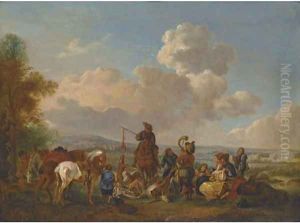Pieter Wouverman Paintings
Pieter Wouverman was a Dutch painter known for his depictions of horses, cavalry scenes, and landscapes, imbuing his works with a dynamic quality and attention to detail. Born in 1620 in Haarlem, Netherlands, into a family with artistic leanings—his father Paulus Wouverman was also a painter—Pieter was one of the leading artists of the Dutch Golden Age. Although his early life is not well-documented, it is believed that he was a pupil of his father and possibly studied under other local artists such as Frans Hals or Pieter van Laer, an artist known for his 'Bamboccianti' scenes of peasant life.
Wouverman's oeuvre includes a wide variety of subjects, but he is best appreciated for his lively and refined treatment of equine subjects. It is speculated that a trip to Hamburg might have influenced his work, as his later paintings often depicted horses in military and leisure contexts, showing a keen observation of these animals in various states of action and repose. This suggests that Wouverman had an intimate knowledge of the animal's anatomy and movement, which was uncommon among many of his contemporaries.
Despite the apparent popularity of his work during his lifetime, Wouverman struggled financially, perhaps due to the sheer number of paintings he produced, which may have lowered their individual value. His style did not evolve significantly over the years; instead, he refined his technique to produce works of consistent quality. Wouverman's paintings were especially popular in France and Germany during his lifetime, and they continued to be sought after by collectors in the centuries that followed.
Pieter Wouverman died in 1668 in Haarlem. His brother Jan and his son Pieter II also became painters, although neither achieved the same level of fame. Today, Wouverman's paintings can be found in major museums around the world, and he is recognized as one of the most important Dutch painters of the 17th century, with his works celebrated for their elegance, detailed craftsmanship, and the vividness with which they portray the vitality of both humans and horses.
